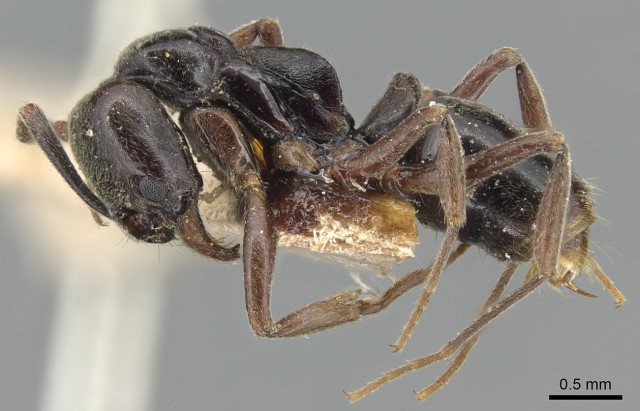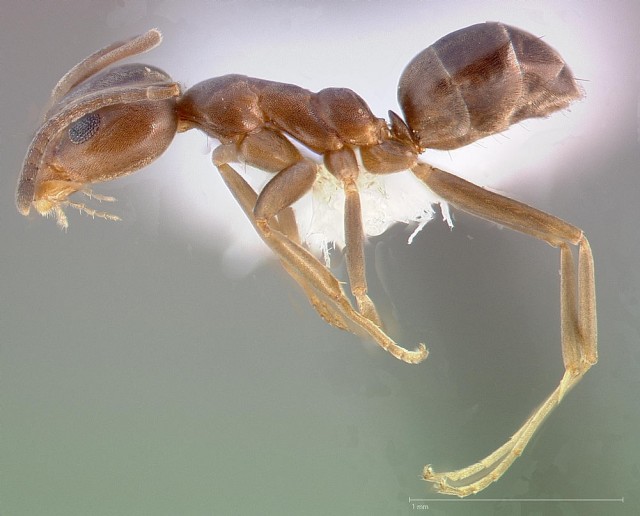The Asian needle ant: Coming to a forest near you
An invasion is brewing and humans could be collateral damage
Andrew P. Han • July 10, 2013

An Asian needle ant, scale included. [Image credit: www.Antweb.org]
Perhaps no ant species has gained more notoriety in recent years than the smallish brown Argentine ant, an aggressive swarmer that has constructed an incomparable empire covering parts of every continent except Antarctica. After coming to the United States by boat in the 1920s, they have overrun native ant species wherever they have been introduced. As with many invaders, they are finally encountering resistance. They have not run up against local opposition, however, but another invasion.
For the first time, scientists have documented another species taking territory from the Argentine ant on its new turf. The larger, venomous and also invasive Asian needle ant has been slowly massing numbers in the American southeast for decades, right under the feet of humans. Several years ago, Eleanor Spicer Rice, an entomologist at North Carolina State University was surprised to find more and more of the Asian needle ants in a suburban office park between Raleigh and Durham that had been dominated by the Argentine ant. She watched for several years as Asian needle ants increasingly took and held nesting sites that had once belonged to Argentine ants.
The results of Rice’s study were published earlier this year in PLOS One. “This is a paper about a species that nobody knows anything about,” she says. But the limited information on the Asian needle ant makes David Holway, an expert on the Argentine ant at the University of California – San Diego, think its success against the Argentine ant may be somewhat overhyped. “I’m not sure what you can say about ants that is general from studying them in an office park,” he says. If the clash of invaders is any indication of what’s to come, millions more people may witness the detriments an ant invasion can bring to human health, native ant species and forest ecosystems.
The earliest reports of the Asian needle ant’s arrival came in 1932, at Norfolk, Va. and Washington, N.C. But they spread slowly and for decades people paid little attention to them. Benoit Guenard, an entomologist at the Okinawa Institute of Science and Technology, thinks that the fire ant diverted human attention away from t he Asian needle ant, since both species have venomous stings. Now though, the needle ants, which hail from northern China and Korea, seem to appear wherever scientists look. In many respects, Pachychondyla chinensis, the Asian needle ant, is a peculiar creature. They are just large enough to fit on a pencil eraser, and can’t climb up slick surfaces like the inside of a glass jar, like other ants can. “They’re not very grippy,” says Rice.
Though they can hunt other insects and come equipped with venomous stingers, she says they are “shy” when compared to some species of ants. Whereas some ants will swarm and attack a human, most altercations between us and Asian needle ants happen because we unknowingly reach into a nest hidden in a mulch or wood pile, or, worse, find them trapped inside clothing. Long, skinny and jet-black, they crawl low to the ground. Rice says they look like “little ninjas.”
Perhaps most peculiar is their method of retrieving food. Unlike most ants, Asian needle ants don’t use chemical signposts to mark the route to dinner. If an ant finds herself with too big of a haul (ants are almost always female), she will return to the nest, signal to another ant to curl up in their version of the fetal position, then pick up the packaged ant with its mandibles and carry it under her belly to the food source. This repeats if necessary, until there are enough ants to retrieve the food. “It’s actually really cute,” Rice says.
On the warm, moist, banks of South America’s Parana River, the Argentine ant is just one among many ant species in constant competition with each other. Because of this competition, the Argentine ant is highly aggressive when searching and fighting for food, says Holway, the UC-SD entomologist. Aggression, though, is not enough for a would-be conqueror. “Nobody ever said the Argentine ant was the most aggressive ant in the world,” says Holway. If other ant species in their native habitat are removed, he says Argentine ants become more abundant, indicating there are local population checks. Holway suggests that humans, who introduce them to less competitive environments, have been a major factor in their success. It appears we have unleashed this pestilence upon ourselves.
One other trait distinguishes the Argentine ant: social organization. In many ant species, individuals from separate colonies compete with and attack each other. However, Argentine ants from distant nests have been shown to recognize each other as being from essentially the same colony. One experiment even showed that ants from Europe, California and Japan all recognized each other as one of their own, meaning they could be considered part of a global supercolony.
On the local scale, it is no different; Argentine ant nests can be thought of as belonging to a single supercolony, akin to a unified Germany, rather than fractured principalities. Once introduced to suitable environments, especially Mediterranean and subtropical climates, the Argentine ant flourishes due to the combination of aggression and ability to form supercolonies. Without competition amongst themselves, they can focus on feeding and breeding. Without the checks on population present in their native habitat, Argentine ant populations explode, with nests containing millions of ants, allowing them to blitzkrieg native ant populations.
So how did the Asian needle ant come to take nesting spots from the vaunted Argentines? This was the question for Rice and her advisor, Jules Silverman. Over the course of four years, they studied ant nests located at the base of oak trees – prime real estate for both species – noting which type of ant established there and when. At first, Asian needle ants were established at only a handful of the sites under observation, sharing them all with Argentine ants. That Asian needle ants were able to coexist with Argentine ants was surprising, says Rice, and how they are able to do so is the subject of a future paper. By the end of the study, Asian needle ants expanded their territory to a third of the sites, completely running the Argentine ants out of half those sites. Asian needle ants do hunt and kill Argentine ants, but Rice thinks the key to their success lies not in what they do, but when.
North Carolina can get cold in winter, with average lows below freezing. “Most ant species basically go to sleep and colony sizes diminish,” she says. But because they’re native to colder latitudes in Korea and China, Asian needle ants begin rebuilding their colonies in March, almost two months before the more aggressive Argentine ants. “Argentine ants can’t make a house for themselves,” says Rice. “Asian needle ants are already there hanging out, eating food and making babies.” The largest Asian needle ant nests only grow to several thousand individuals and Argentine Ants can outnumber them by as much as five to one by the summer months, says Rice. But once Asian needle ants take over a site, they never relinquish it. “They can hold their ground against just about anybody,” she says.This includes humans as well as ants.
Asian needle ants are gatherers as well as hunters, which leads them into close contact with people. “We have even found a nest in a school cafeteria under a floor mat, where the ants were eating food that had come out of the dishwasher,” says Rice. Proximity inevitably leads to conflict and sometimes humans are on the losing side. The ants’ venom packs a wallop: preliminary data from South Korea suggest that as many as two percent of people have severe allergic reactions that could end in death, more than three times the incidence of similar reactions to bee stings. “The pain of the Asian needle ant sting is much stronger than that of the fire ant,” says Guenard, “I’ve experienced both many times.”
For some humans, Argentine ants are little more than common house pests, but they are not without impact. In what has become our natural response to insect infestations, we spray copious amounts of chemical pesticides in hopes to control them. “The environmental impacts are probably pretty serious” Holway says. The Argentine ant takes the biggest environmental toll in places untouched by the spread of humans. “It seems to hammer native ants,” says Holway, especially in Hawaii and other island ecosystems. California is another well documented example, he says, where even the California Horned Lizard is now threatened because the native ant species it feeds on have been washed away in the tidal wave of Argentine ants.
Asian needle ants, though not as well established, could have a similarly disruptive impact on forests in the eastern U.S. Like the Argentine ant, they are very good at replacing native species. This is a problem, Rice says, because native ants perform important functions such as enriching soil like earthworms and planting seeds in the forest floor. “When you take these ants away, parts of the fabric of nature kind of fall apart,” she says. “Asian needle ants are down there in our National Parks, displacing ants.”
Rice works with a citizen science project called School of Ants, where people can submit samples of ants in their area to help scientists create a census of ant species around the country. She says Asian needle ants are turning up everywhere across the U.S. – as far north as New York City and as far west as Washington. “Five years ago, nobody knew what the Asian needle ant was,” says Rice. “Now it’s one of the most common ants in the United States.”
As much of a nuisance as Argentine ants can be, their damage to the eastern U.S. seems to be limited by several constraints. North Carolina is about as far north as they can go, Holway says, and there they appear to live only in areas already affected by human development, posing little ecological threat.
But he acknowledges that where the Argentine ant has failed to penetrate – northern, forested areas – the Asian needle ant is primed to succeed, and is only becoming more prevalent. With their potential to threaten ecosystems, as well as human health, even a skeptic like Holway warns: “it’s potentially a big problem.”
